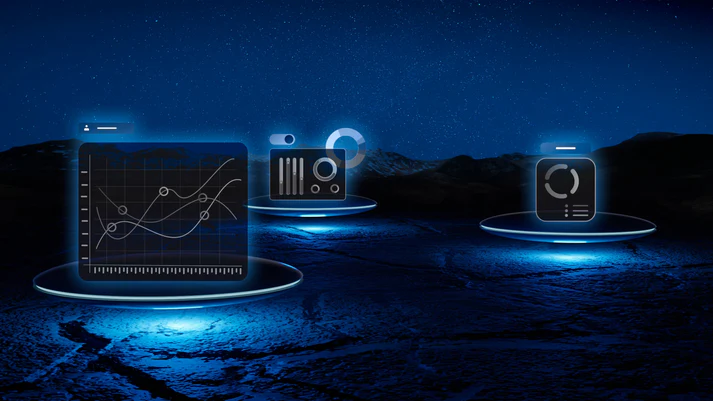Generative AI, the new wave in the dynamic landscape of cloud based artificial intelligence. Gen AI has smoothly emerged as one of focus points of innovation. The rise of Generative AI attributes to its capacity to create and formulate new content, text, image, etc., that mirrors human creativity. Generative AI’s appeal lies in its power to reshape industries and redefine human-machine collaboration across art, language, and problem-solving domains.
What is Generative AI?
Generative AI is a collection of algorithms that is capable of generating new and original content. For example, AI-generated text, images, videos, or audio, from the network of information it is trained with. The Gen AI algorithms that are advanced most often rely on foundational machine learning models that are trained with massive amounts of unlabelled data using self-supervised methods. These models identify patterns for various tasks with remarkable effectiveness.
How does Generative Artificial Intelligence work?
With a simplified, user-friendly process, Generative Artificial Intelligence eases content creation:
Step 1: Building an Information Database
A vast network is created that contains a variety of material, including text, photos, audio, and more.
Step 2: Providing a Prompt
Users provide a preview or outline of the material they want to produce.
Step 3: Content Generation
The given information network is used by the AI to create original content.
The entire process starts by entering a prompt, which is likely to be presented in the form of text, photos, and videos, among other media options. After the request has been sent, all the algorithms get to work to produce original content. The results vary from answers to problems to essays and even high-quality images. After the results are generated, one can also ask for changes and customize the results with the style, tone, etc.
In the early versions of Gen AI, data needed to be submitted with complex techniques like APIs and Python scripting. With recent developments, innovators in Gen AI are developing ways that let users explain a request in plain language.
Fact check: The stakes are high. AI could contribute more than $15 trillion to the global economy by 2030, according to PwC.
Advantages of Generative AI
Generative AI holds immense potential across various business domains, simplifying content interpretation and generation. It’s being harnessed to enhance established workflows and even overhaul them to leverage its capabilities thoroughly.
The advantages of integrating generative AI encompass:
- Streamlining manual content creation processes.
- Minimizing the labor involved in email replies.
- Enhancing the handling of precise technical inquiries.
- Crafting lifelike depictions of individuals.
- Condensing intricate data into coherent narratives.
- Facilitating the production of content in specific styles.
Impact of Generative Artificial Intelligence on Cloud Computing
Gen AI’s integration with cloud computing has emerged to accelerate innovation across industries and act as a transformative catalyst. This unveils a world full of possibilities and revolutionary developments. It provides scalable infrastructure while Gen AI continues to push creativity and innovation. The combination of cloud AI technologies with generative AI speeds up the iterative process of ideation and prototyping and creates a vibrant environment for collaboration and experimentation. Cloud and Gen AI promise to democratize the AI technologies and enable a wider audience to utilize the potential across industries.
Why is Generative AI crucial for business success?
Generative AI has the capability to improve and automate every element of your corporate operations, from software development and business management to customer care and data analytics.
For instance –
– To improve customer engagement by enabling self-service and giving everyone the greatest possible experience.
– To automate high-volume processes like handling communications and insurance claims, as well as duties involving software development. – To facilitate the understanding of all relevant unstructured data by your teams, including contracts, bills, customer comments, policies, and performance evaluations.
Rapyder’s Generative AI Solution for enterprises
Given that ChatGPT isn’t tailored to manage enterprise data with its unique domain knowledge, terminology, and privacy requisites, we’ve engineered a solution. This solution empowers enterprise clients to harness the potential of generative Artificial Intelligence within their proprietary data. Through Rapyder’s solution, you can establish an experience akin to ChatGPT, tailored to your data, utilizing cutting-edge generative machine learning models like OpenAI’s ChatGPT.
Our solution furnishes enterprise customers with the tools to leverage generative AI within the context of their enterprise data. This offers avenues for enhancing customer service, boosting employee engagement, extracting business insights, and more.
Our approach relies on the synergy of two potent AI technologies: the OpenAI GPT3.5-turbo model and Azure Cognitive Search. The GPT3.5-turbo model represents a large-scale machine learning language model proficient in generating coherent and natural text across diverse subjects. Azure Cognitive Search, a cloud service, streamlines data indexing and retrieval. By harmonizing these AI technologies, we implement a technique called Retrieval Augmented Generation (RAG), enabling the generative AI application to craft responses exclusively from user data.
Our solution boasts the following features:
- Engage with your data as though conversing with a human.
- Integrate semantic search capabilities into your data interactions.
- Deliver personalized outcomes solely sourced from your data.
- Facilitate dynamic chat sessions and Q&A interactions.
- Provide users with options to assess content reliability through citations and traceability.
- Empower users to fine-tune the behavior of the Generative AI model.




